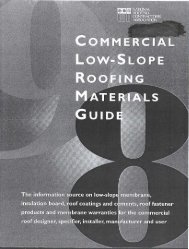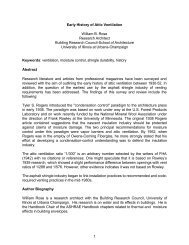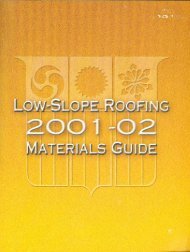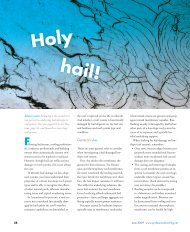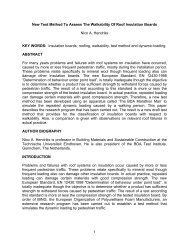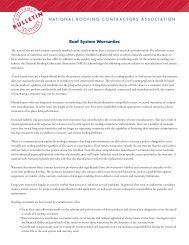! j I I - National Roofing Contractors Association
! j I I - National Roofing Contractors Association
! j I I - National Roofing Contractors Association
- No tags were found...
You also want an ePaper? Increase the reach of your titles
YUMPU automatically turns print PDFs into web optimized ePapers that Google loves.
or with a reinforcing fabric. Neoprene roof membranes have applications since the mid.1960s, NBP reinforced single-plyexcellent resistance to weather, heat, oils, solvents, and abra- membranes exhibit excellent tear and puncture resistance,sion. The characteristics of neoprene adhesives allow fabri. good weatherability, remain flexible at low temperatures, andcation of field splices that achieve high seam strength to have a low water vapor permeability. They are resistant toprovide a reliable continous weatherproofing membrane. most chemicals but are sensitive to aromatic hydrocarbons.Some formulations are available that will receive a coatingof liquid Hypalon synthetic rubber when a stable uniform Thermoplasticscolor is desired for the roof membrane. These special non. I. PVC PVC (polyvinyl chloride) polymers, originally prostainingneoprene products require such a coating for weather duced in Germany almost thirty years ago, are among theprotection.most versatile of thermoplastics for industrial and commercialapplications. They are produced by the polymerizationNon-Vulcanized Elastomers of vinyl chloride monomer, a gaseous substance resultingI. CSPE Chlorosulfonated polyethylene, a synthetic rubber from the reaction of ethylene with oxygen and hydrochloricmanufactured by DuPont, was introduced in 1951 under the acid. In its most basic form, the resin is a relatively hardtrade name Hypalon.* It is a self-curing non-vulcanized material that requires the addition of other compounds, comelastomerand is available as a liquid coating or in sheet form monly pasticizers and stabilizers, as well as certain other in.for single-ply membrane application. CSPE sheet roofing gredients, to produce the desired physical properties for endmembranes have been in use since 1966. They may be rein- use. PVC membranes may be produced by calendering, exforcedwith polyester scrim or laminated to felt backing truding, or spread.coating, and they may be nonreinforcedmaterials, and have a finished thickness of 30 to 60 mils. CSPE or reinforced with glass fibers or polyester fabric. They areis a non-vulcanized product that exhibits thermoplastic qual- usually 40 to 48 mils thick. PVC membranes are available thatities during processing and field installation. During roof ex- have provided up to twenty years of service life as exposedposure, curing or cross-linking occurs. CSPE exhibits strong roofing. They are resistant to bacterial growth, industrialresistance to weathering and a broad range of chemicals and chemical atmospheres, roof penetration, and extreme weatherpollutants, as well as being inherently ozone resistant. It may conditions. PVC membranes properly formulated have shownbe produced in many colors and offers design versatility be- excellent fire resistance and seaming capabilities. PVC memcauseof its adaptability to a variety of roof shapes and sub- branes are chemically incompatible with bituminous materials.strates. 2. EIP EIP are thermoplastic compounds consisting of ethy-2. CPE Chlorinated polyethylene was first introduced to the lene interpolymers, stabilizers, pigments, anti-oxidants, andsingle-ply membrane roofing market in 1964. The rawmateri- modifying polymers. EIP membranes are generally reinforcedals used are manufactured by the Dow Chemical Co. CPE with polyester fabric and are usually 32 mils thick. They posmaybe formulated for use as roofing membranes as both sess good resistance to fire, chemicals, and oils and have highcured and uncured elastomers. They may be nonreinforced tear strength. Many formulations utilizing combinations ofor reinforced with scrim and range in thickness from 40 to ethylene polymers with other' basic ingredients can be48 mils. They are inherently flexible and do not require the produced.addition of plasticizers in their formulations. CPE exhibitsstrong resistance to oils and chemicals. excellent weathera- Modified Bitumensbility, and ozone resistance. They are also resistant to bitu- Polymer modified bituminous membranes were developedmen and can therefore be installed directly over existing in Europe in the mid-1960s and have been in use in the Unitasphaltor coal tar pitch roofs. Although usually produced ed States since 1975. Both the bitumen and polymers ';lsedin white or light gray for reflectivity and energy efficiency, in these systems have been carefully selected and combInedCPE can also be pigmented to a variety of colors.to result in an engineered coating that is coupled with vari-. . . ous reinforcements to form a membrane specifically designed3. PIB ~IB (poIYlsobutylene) IS an elasto~enc compound, to meet the requirements for successful performance in amade of Isobutylene and .other pol~ers, whIch was first used roofing system. The modifying compounds, such as styrene-as ~ roofing mem.brane.1ll Europe III the 1960s. It ~as been butadiene or atactic polypropylene, impart flexibility andav.allable domestlca~ly III the form .used .today sInce th~ elasticity, and improve cohesive strength, resistance to flowmld-1970s. The 5O-m!1 pm membra~e IS la~mated to a 40-mll at high temperatures, and toughness'. Reinforcing materialsnon-wo~en synt~etlc fleece bac~mg wIth an ';l~backed consist variously of plastic film, polyester mat, glass fibers,pre!abncated sealing ~dge for th~ sIde .laps. pm exh~blts good felt, or fabric; they may be embedded within or laminatedresIstance to weatherIng, ultTavlolet light, and radIant heat. to the surface of the modified bitumen membrane. The mem-It is c.o~patible with. asl:>halt, but is not resistant to pe~r~le- brane may be surfaced with liquid coatings, metallicurn dIstillates, organic 011 and fats, or substances contammg laminates, ceramic granules, or mineral aggregates to enhancetar.UV and fire resistance. Modified bitumen membTanes range4. NBP NBP nitrile alloy membranes are compounded from in thickness from 40 to 160 mils.butadiene-acrylonitrile copolymers with other proprietary ingredients.They are typically reinforced with polyester andrange in thickness from 30 to 45 mils. First developed in the PHYSICAL PROPERTIESmid-1960s, nitTile alloys have been used in engineering ap- .plications in the aircraft, automotive, and geomembrane Althou~h It IS dIfficult to dIrectly c~ITelate physIcal propertyindustries. Used extensively for weather and waterproofing data wIth actual performance or life expectancy, manufacturerstypically utilize such data in their quality control pro-* Hypalon is a registeTed tTade mark of E.I. DuPont de grams to ensure the suitability of the compound for its endNemours & Co.use..-16


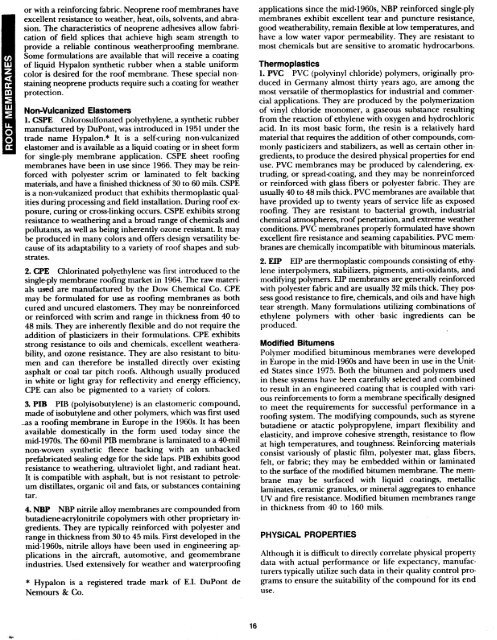

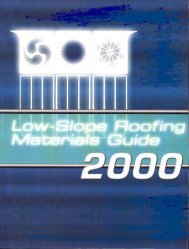
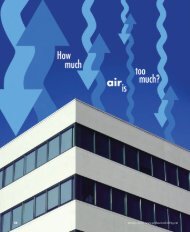

![Wm] - National Roofing Contractors Association](https://img.yumpu.com/36696816/1/190x245/wm-national-roofing-contractors-association.jpg?quality=85)

